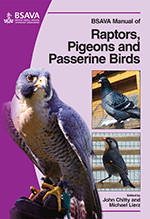
Full text loading...

As with all species, an understanding of what is normal, and what is not, is essential. Skin physiology is similar to that of other birds, but the moult does have an impact of the working raptor. This chapter looks at anatomy and physiology; approach to feather and skin cases; feather diseases; feather destructive disorders; skin diseases; and specific disorders.
Raptors: feather and skin diseases, Page 1 of 1
< Previous page | Next page > /docserver/preview/fulltext/10.22233/9781910443101/9781910443101.24-1.gif

Full text loading...










